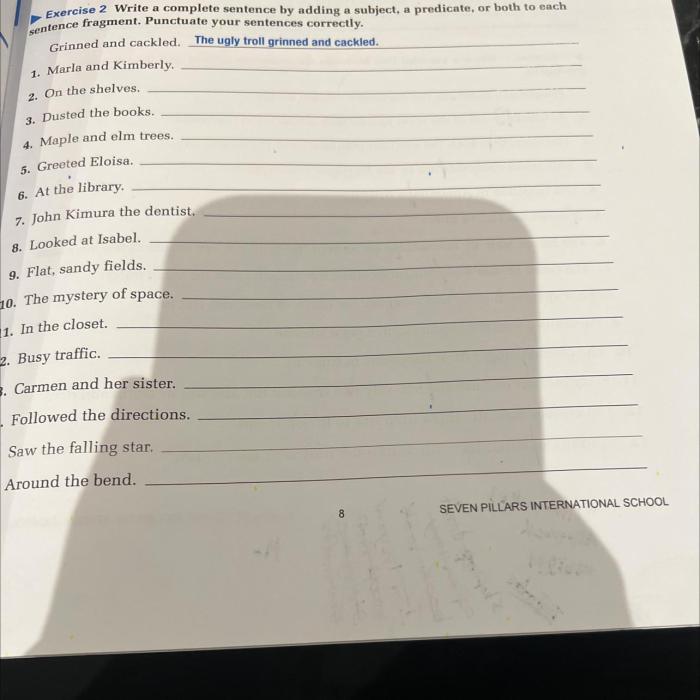Unit 1 subjects predicates and sentences answer key – Embark on an enlightening journey with our comprehensive Unit 1 Subjects, Predicates, and Sentences Answer Key. This meticulously crafted guide unveils the fundamental elements of sentence construction, empowering you with the knowledge to dissect and construct sentences with precision.
Delve into the intricacies of subject identification, predicate recognition, and sentence structure analysis. Discover the rules governing subject-predicate agreement and master the art of sentence diagramming. Prepare to elevate your understanding of sentence construction and unlock a world of effective communication.
Subjects, Predicates, and Sentences

Understanding the fundamental elements of a sentence, namely subjects, predicates, and their relationship, is crucial for constructing grammatically sound and meaningful sentences. This article provides a comprehensive overview of these key concepts, guiding you through their identification, analysis, and application in sentence construction.
Subject Identification
A subject is the noun, pronoun, or noun phrase that performs the action or is in a state of being described by the predicate. To identify the subject, ask “Who” or “What” is performing the action or being described.
- Simple Subject:A single word or phrase that acts as the subject, e.g., “The boy” in “The boy is running.”
- Compound Subject:Two or more subjects joined by a coordinating conjunction, e.g., “The boy and the girl” in “The boy and the girl are playing.”
- Complex Subject:A subject that includes a dependent clause, e.g., “The student who studies hard” in “The student who studies hard will succeed.”
Predicate Recognition
A predicate is the part of a sentence that contains the verb and provides information about the subject. It describes the action or state of being of the subject.
- Simple Predicate:A single verb or verb phrase that forms the predicate, e.g., “is running” in “The boy is running.”
- Compound Predicate:Two or more verbs or verb phrases joined by a coordinating conjunction, e.g., “ran and jumped” in “The boy ran and jumped.”
- Complex Predicate:A predicate that includes a dependent clause, e.g., “will succeed” in “The student who studies hard will succeed.”
Sentence Structure Analysis, Unit 1 subjects predicates and sentences answer key
The basic structure of a sentence consists of a subject and a predicate. However, sentences can also include other elements such as objects, modifiers, and complements.
- Simple Sentence:A sentence with a single independent clause, e.g., “The boy is running.”
- Compound Sentence:A sentence with two or more independent clauses joined by a coordinating conjunction, e.g., “The boy is running and the girl is singing.”
- Complex Sentence:A sentence with an independent clause and one or more dependent clauses, e.g., “The boy who studies hard will succeed.”
Sentence Classification
| Sentence Type | Purpose | Punctuation |
|---|---|---|
| Declarative | Makes a statement | Period (.) |
| Interrogative | Asks a question | Question mark (?) |
| Imperative | Gives a command or request | Exclamation point (!) |
| Exclamatory | Expresses strong emotion | Exclamation point (!) |
Subject-Predicate Agreement
Subject-predicate agreement means that the verb in the predicate must match the number and person of the subject. For example, if the subject is singular, the verb must be singular; if the subject is plural, the verb must be plural.
- Singular Subject:Requires a singular verb, e.g., “The boy runs.”
- Plural Subject:Requires a plural verb, e.g., “The boys run.”
- Indefinite Pronouns:Some indefinite pronouns, such as “each” and “everyone,” require singular verbs.
Sentence Diagramming
Sentence diagramming is a visual representation of the grammatical structure of a sentence. It helps to identify the subject, predicate, and other elements, and to understand their relationships.
- Identify the Subject:Draw a line below the subject.
- Identify the Predicate:Draw a line above the predicate.
- Connect the Subject and Predicate:Draw a vertical line connecting the subject and predicate.
- Identify Other Elements:Draw lines to connect other elements, such as objects and modifiers, to the subject or predicate.
FAQ Guide: Unit 1 Subjects Predicates And Sentences Answer Key
What is the primary purpose of a subject in a sentence?
To identify the person, place, or thing performing the action or experiencing the state of being described by the verb.
How can I distinguish between different types of predicates?
Look for the verb and any words or phrases that complete its meaning, such as objects, complements, or modifiers.
What are the key principles of subject-predicate agreement?
The subject and verb must agree in number (singular or plural) and person (first, second, or third).

